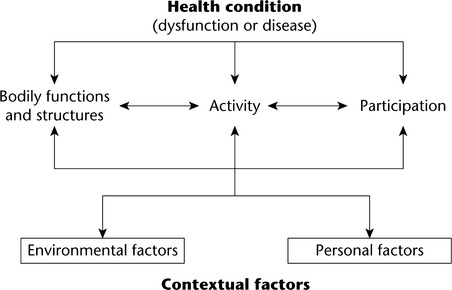2. The overall goal of communication for health professionals
CHAPTER OBJECTIVES
• Understand the relevance of the WHO ICF model when communicating with a person seeking their assistance
• Understand the overall purpose of communication for the health professions
• Recognise the steps required to fulfil the overall purpose of communication in the health professions
• Understand and recognise the characteristics of each step.
While the purpose of communication in the health professions is ultimately to facilitate the delivery of a service, the overall goal of communication for health professionals should be to communicate in a manner that makes the delivery of the service a positive experience for all. This chapter describes the means of achieving this goal to ensure optimum health and wellbeing for all people seeking the services of a health professional.
A model demonstrating the importance of communication
The International Classification of Functioning (ICF) shown in Figure 2.1 (World Health Organization [WHO] 2001) is a biopsychosocial model that highlights the complex and multidimensional nature of health and the factors affecting health and functioning (Allan et al 2006). It provides a common language for multidisciplinary or interdisciplinary communication. The ICF classifies the ‘components of health’ and places health on a continuum where any limitation in functioning can disrupt health.
 |
| FIGURE 2.1 Adapted from WHO ICF 2001, p 18. WHO ICF |
The ICF also describes the importance of participation in six interrelated domains or life situations (Ewert et al 2004, Weigl et al 2004), including
• Communication
• Movement
• Learning and applying knowledge
• Self-care and interpersonal interactions
• Major life areas associated with work, school and family life.
The ICF model encourages health professionals to consider the factors that affect function and participation. It directs health professionals to collaborate with the person to overcome the challenges that restrict participation in a chosen activity, because participation contributes to health. It directs health professionals to develop holistic goals that are person-centred and thus unique to the needs of the individual (Brown et al 2003).
The ICF model indicates that communication is an important domain that facilitates participation and functioning and thus significantly affects health. It reminds health professionals to acknowledge the importance of communication for health and a sense of wellbeing, and therefore to encourage the individual to engage in the act of communicating.
The general purpose of communication for the health professions
Health professions exist to provide specific services to individuals seeking their assistance. Regardless of the particular health profession, communication is a vital activity within that service. Mutual understanding between the individual seeking the service and the health professional is vital to ensure positive outcomes; it is a characteristic of any meaningful interaction. Mutual understanding provides the foundation for the development of a therapeutic relationship between the individual and the health professional. Similarly, this therapeutic relationship ensures that the individual or group is at the centre of the goals and interventions, thereby facilitating family-centred, client-centred or person-centred practice (Parker 2006, Harms 2007, Higgs et al 2005, Purtilo & Haddad 2002, Rini & Grace 1999, Stein-Parbury 2006) (see Figure 2.2).
 |
| FIGURE 2.2 |
The concept of family/person-centred practice is the focus of discussion and publication in some health professions. In other health professions it is an underlying assumption but rarely discussed, while in others it is neither an assumption nor a topic of discussion.
Family/person-centred practice is a partnership between the health professional and the person/people seeking their services. This collaborative partnership exists to establish the needs of the person (Unsworth 2004) and enable them to achieve their goals through the assistance of the health professional (Duncan 2006). Achievement of these goals empowers the individual to experience participation and fulfilment in their daily lives.
Mutual understanding
Mutual understanding means that those communicating share a common meaning – all parties comprehend the verbal and non-verbal signals used during the interaction. In the health professions, mutual understanding must mean more than simply understanding words (see Ch 1).
A foundation factor that builds mutual understanding and appropriate results in any health profession is respect (Egan 2007). Respect of self and the other is a fundamental value of all health professions. It affects the views that individuals have of themselves and of others. It requires unconditional regard for self and the other regardless of weaknesses or failures, position or status, beliefs and values, material possessions and socioeconomic level (Purtilo & Haddad 2002). Respect demonstrates that the health professional values every individual. It is the basis of empathic reactions in a health professional.
As a health professional it is imperative to understand that every person seeking assistance feels disconnected and vulnerable. The individual often feels inadequate to meet the demands of their situation (Stein-Parbury 2006) and may be afraid of the unknown elements of the situation. Vulnerable individuals want to know that the health professionals around them care about them and want to understand their experiences (Milliken & Honeycutt 2004). It is the responsibility of the health professional to demonstrate this care and facilitate understanding of the vulnerability of each individual. Direct, clear and accurate understanding of the emotions of the individual and expression of this understanding is known as empathy (Stein-Parbury 2006). Davis (2006) states that expressing empathy to the vulnerable individual enables the health professional to communicate both ‘humanistically and therapeutically’. This manner of communicating has a positive effect (Ley 1998) upon the participation of the individual in all activities associated with seeking assistance from the health professional (see Figure 2.3).
 Stay updated, free articles. Join our Telegram channel
Full access? Get Clinical Tree
 Get Clinical Tree app for offline access
Get Clinical Tree app for offline access
Get Clinical Tree app for offline access

|